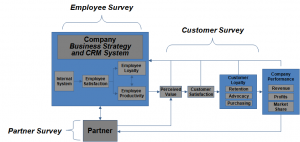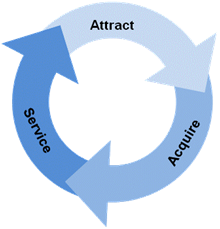Customer loyalty and customer lifetime value are two different, yet related, areas of study. The purpose of this discussion is to outline each area and highlight how knowledge in both areas is necessary to better understand how to grow a company. Companies are not static entities; they make business decisions in hopes to increase customer loyalty and grow their business. The key to business growth is to make decisions that will improve customer loyalty. Customer loyalty management is the practice of determining how to maximize customer loyalty. To understand how improvements in customer loyalty will improve business growth, we need to first understand the value of customers to the organization.
Customer Lifetime Value (CLV)
Customer lifetime value reflects the present total value of a customer to the company over his or her lifetime. The concept of CLV implies that each customer (or customer segment) differs with respect to their value to the company. When we discuss CLV, we typically refer to the value of a single customer, whether that customer represents the typical customer overall or the average customer within a customer segment (e.g., West coast customer vs. East coast customer).
The generic model of CLV can be broken down as a function of four elements:
- NC: Number of customers
- NP: Number of times the average customer make a purchase each year
- CL: Average customer life (in years)
- PPS: Average profit per sale (total sales revenue – costs)/number of sales
Using these elements, we can calculate the customer lifetime value for the entire customer base (or customer segment):
CLV = NC x NP x CL x PPS
Increasing the Lifetime Value of the Customers
Organizations, using this CLV model, can now view customers as assets with a specified value that, in turn, becomes the basis for making business decisions. The goal for management, then, is to maximize the CLV to the company. To increase the lifetime value of the customers, organizations can do one or more of the following four things:
- Increase size of the customer base (or customer segments)
- Increase the number of purchases customers makes
- Increase the average customer life
- Increase profits per sale
We see that higher CLV equates to greater financial growth with respect to profits and a greater likelihood of long-term business success. It is important to note that, because the CLV is a multiplicative function of four elements, a negative value of profits (costs are greater than revenue) results in a negative CLV no matter how large the other elements of the CLV become. Therefore, before trying to manage the loyalty of a particular customer segment, it is important to know if the customer segment is worth growing or even worth having. This step involves calculating the profits per sale.
Providing a value for profit is oftentimes a game of guesswork due to the lack of understanding of costs associated with a given customer relationship. Costs may be difficult to quantify due to the lack of available data needed to make such precise calculations or costs may be overlooked due to a lack of understanding of the company resources necessary to maintain relationships with customers. The estimation procedure of the profit value should be transparent and shared across the organization to ensure assumptions about its calculation are reviewed by all interested parties.
While the concept of CLV has been traditionally applied in the sales/marketing field to understand the cost of attracting new customers, more comprehensive CLV models include costs associated with other phases of the customer lifecycle. Consider the customer lifecycle model in Figure 1. We see that a customers’ tenure with the company involves three general phases, attraction (marketing), acquisition (sales), and service (service). Within each customer lifecycle phase, company resources are required to maintain a relationship with customers. Accordingly, to get a more accurate estimation of the customer lifetime value, organizations are now including the costs to service the customers. Extending beyond the costs of attracting and acquiring customers, servicing costs expend organizational resources such as customer service staff costs and employee training costs, just to name a few. These service costs, along with sales/marketing costs, should be included in the estimation of profit per sale.
Once these costs associated with a given customer group can be established, the lifetime value of that customer group can be determined. While some customer segments could be very profitable, other customer segments might not be profitable at all.
Customer Loyalty Measurement
After identifying the extent to which a customer segment is profitable or not, the organization now must make a choice whether or not they want to invest in that customer segment to increase the lifetime value of the customers in that segment. Clearly, a customer segment that is costing more to maintain than the revenue it generates should raise red flags across the organization. In this situation, the organization can either attempt to decrease the costs of maintaining these relationships or simply attrite these relationships. For a customer segment that is profitable, the organization can determine how best to increase the lifetime value of that segment through loyalty management.
In the next step, the organization needs to understand how they can increase the lifetime value of the customers in the profitable customer segments. From the remaining elements of the CLV, the organization can improve the CLV by focusing on one or more of the customer-focused elements of the CLV model. Specifically, a company can increase the size of the customer base, increase the purchasing behaviors of the customer base, and increase the tenure of the customer base.Each of the customer-centric elements of the CLV correspond directly to each the three facets of customer loyalty identified through our research on customer loyalty. These three facets of customer loyalty include 1) Advocacy Loyalty, 2) Purchasing Loyalty and 3) Retention Loyalty.
Business Model and Customer Lifetime Value
Customer surveys can result in hundreds of thousands of data points for large organizations. Consider one high-tech company who surveys their customer base bi-annually with a survey that contains roughly 50 questions (both loyalty questions and business attribute questions). Given a sample size of 14,000 respondents per survey period, this company has 1.4 million pieces of customer feedback data annually with which to help them manage their customer relationship! While most companies might not have the magnitude of customer feedback data as this company, even smaller amounts of data (20,000 data points from 20 questions and 1000 respondents) can overwhelm a company trying to use their data intelligently to manage their customer relationships.
Business Model. To help us understand how to use the data, we can employ models to help us put the data in context. There are many different types of models regarding customer satisfaction and loyalty (ACSI, 2008; Heskett, Sasser & Schlesinger, 1997) but they all have basic elements in common. A basic model incorporating common elements of each of these models appears in Figure 2.

Figure 2. Marketing/Sales/Service Business Model and the Relationship among Key Organizational Variables (Adapted from Heskett, Sasser & Schlesinger, 1997 and ACSI, 2008)
This business model illustrates the interrelatedness of the organizational variables that ultimately impact the company’s financial performance. Empirical research shows that business growth is stimulated primarily by customer loyalty. Loyalty is a direct result of customer satisfaction, and satisfaction is largely influenced by the value of services provided to customers. Value is created by satisfied, loyal, and productive employees. Employee satisfaction, in turn, is impacted by the business strategies and internal systems that enable employees to deliver results to customers. Partners also provide products and services to joint customers and help to impact customer loyalty to the partnering company.
Customer Lifetime Value. Older models examining the relationships among organizational variables, whether purposefully or not, do not make the distinction among the different facets of customer loyalty. The distinction of the facets of customer loyalty goes beyond recent thinking regarding the simplistic notion that customer relationship management can be effectively conducted with a single loyalty item.
Increasing the lifetime value of customers requires the management of all three types of loyalty in the customer base (or segment). By measuring each type of customer loyalty, executives can more effectively manage their customer relationships by examining each type of loyalty. Loyalty management allows companies to address new customer growth, purchase behavior, and customer retention. To improve the CLV, business decisions can now be targeted to address specific types of loyalty concerns.




 Beyond the Ultimate Question
Beyond the Ultimate Question Measuring Customer Satisfaction and Loyalty (3rd Ed.)
Measuring Customer Satisfaction and Loyalty (3rd Ed.)
Hi Bob,
Your article is really helpful, thanks for writing. I am looking forward to read more articles in future. Keep writing!!! cheers.